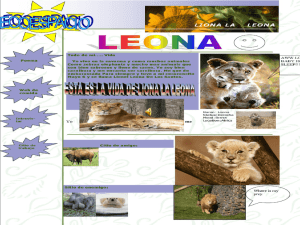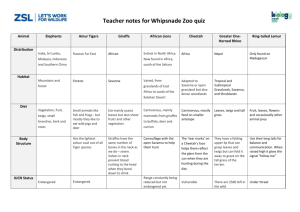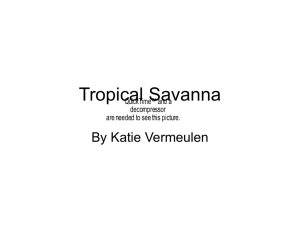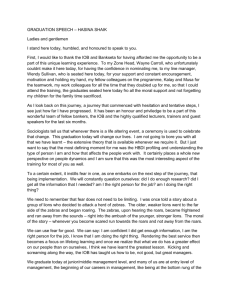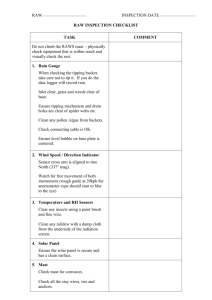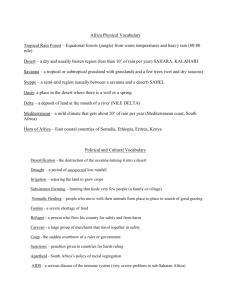Here Is the African Savanna
advertisement
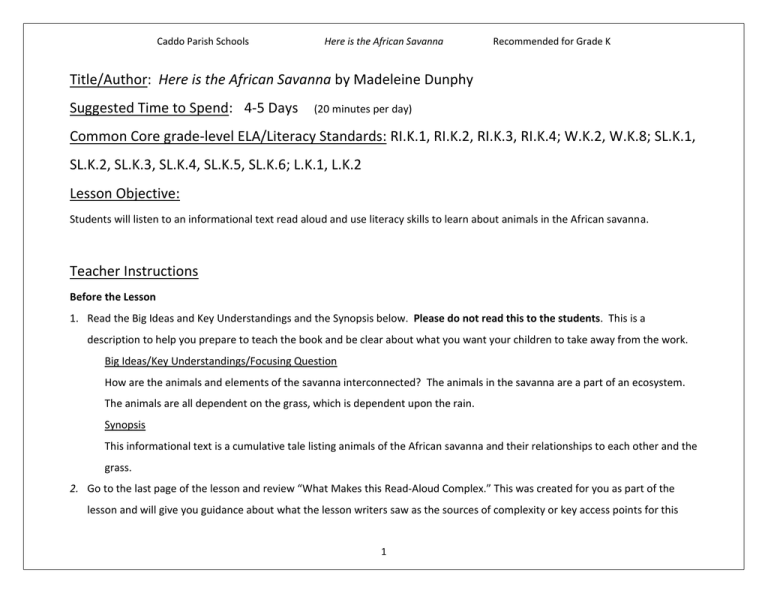
Caddo Parish Schools Here is the African Savanna Recommended for Grade K Title/Author: Here is the African Savanna by Madeleine Dunphy Suggested Time to Spend: 4-5 Days (20 minutes per day) Common Core grade-level ELA/Literacy Standards: RI.K.1, RI.K.2, RI.K.3, RI.K.4; W.K.2, W.K.8; SL.K.1, SL.K.2, SL.K.3, SL.K.4, SL.K.5, SL.K.6; L.K.1, L.K.2 Lesson Objective: Students will listen to an informational text read aloud and use literacy skills to learn about animals in the African savanna. Teacher Instructions Before the Lesson 1. Read the Big Ideas and Key Understandings and the Synopsis below. Please do not read this to the students. This is a description to help you prepare to teach the book and be clear about what you want your children to take away from the work. Big Ideas/Key Understandings/Focusing Question How are the animals and elements of the savanna interconnected? The animals in the savanna are a part of an ecosystem. The animals are all dependent on the grass, which is dependent upon the rain. Synopsis This informational text is a cumulative tale listing animals of the African savanna and their relationships to each other and the grass. 2. Go to the last page of the lesson and review “What Makes this Read-Aloud Complex.” This was created for you as part of the lesson and will give you guidance about what the lesson writers saw as the sources of complexity or key access points for this 1 Caddo Parish Schools Here is the African Savanna Recommended for Grade K book. You will of course evaluate text complexity with your own students in mind, and make adjustments to the lesson pacing and even the suggested activities and questions. 3. Read the entire book, adding your own insights to the understandings identified. Also note the stopping points for the textinspired questions and activities. The Lesson – Questions, Activities, and Tasks Questions/Activities/Vocabulary/Tasks FIRST READING: Read aloud the entire book with minimal interruptions. Stop to provide word meanings or clarify only when you know the majority of your students will be confused. SECOND READING: Give each student a paddle or a tongue depressor the picture of one of the characters in the story. The name of the character can be written underneath the picture. (elephant, river, hippo, tick bird, impala, pod, tree, baboon, giraffe, lion, zebra, grass, rain) Explain to the students that they will hold up their paddles when their character is mentioned. Teacher restates words with information in the parentheses. Reread pages 1 and 2 “Here is the African savanna (flat grassy area sometimes called a plain).” Using the illustration on pages 1 and 2, have the students identify their character and group themselves according to character (ex. All giraffes together, all hippos together, etc.) Reread pages 3 and 4 “Here is the grass that grows on the plain (flat grassy area) Expected Outcome or Response (for each) The goal here is for students to enjoy the book, both writing and pictures, and to experience it as a whole. This will give them some context and sense of completion before they dive into examining the parts of the book more carefully. Each student receives a paddle containing one picture of a character from the text. Students pair up according to the character on their paddle. Students with grass will hold up their paddles. 2 Caddo Parish Schools Here is the African Savanna Recommended for Grade K which turns green or brown depending on rain: Here is the African savanna.” Guide the students in looking at the animals approaching in the picture. What are the animals, and which one is closer. How can you tell which one is closer? Turn and tell your partner. Reread pages 5 and 6 “Here are the zebras who eat the grass that grows on the plain which turns green or brown depending on rain: Here is the African savanna.” Direct the students to look at the illustration and tell what happened to the zebras. Reread pages 7 and 8 “Here are the lions who stalk (track or hunt) the zebras who eat the grass that grows on the plain which turns green or brown depending on rain: Here is the African savanna.” Guide the students in looking at the illustration; the illustrator is helping the reader to understand the order of the animals’ appearance. Ask who is closer now; what happened to the zebras; what other animal is in the picture, and why is he there. Reread pages 9 and 10 “Here is the giraffe who watches the lions who stalk the zebras who eat the grass that grows on the plain which turns green or brown depending on rain: Here is the African savanna.” Guide the students in looking at the illustration. Which animal left; who is the main character in the picture; who is coming next and why? Students with rain will hold up their paddles. Reread pages 11 and 12 “Here is the tree which shades the giraffe who watches the lions who stalk the zebras who eat the grass that grows on the Students with trees will hold up their paddles, and those with giraffes, lions, zebras, grass, and rain will hold up their paddles. Zebras and lions are approaching in the picture. The zebras are closer, and the lions are farther away. The lions are smaller, helping the reader to know they are farther away. Students with zebras will hold up their paddles, and those with grass and rain will hold up their paddles. The zebras are bigger, they got closer. Students with lions will hold up their paddles, and those with zebras, grass, and rain will hold up their paddles. The lion is closer now (because he is bigger); we can barely see the zebras, so they are going away; one giraffe is in the picture (because he is going to be on the next page). Students with giraffes will hold up their paddles, and those with lions, zebras, grass, and rain will hold up their paddles. The lions left (they are small); the giraffe is the main character (he is big); the baboons might be coming next because we can see their bottoms, feet and a tail in the picture. 3 Caddo Parish Schools Here is the African Savanna plain which turns green or brown depending on rain: Here is the African savanna.” Teacher thinks aloud, “The baboons are not next in the story, let’s look back at the illustrations and see how the illustrator is helping to tell the story.” Go back to pages 1-2, read the lines and ask the students if all characters are in the illustration. Turn to pages 3-4, read the lines and ask what characters are visible. Turn to pages 5-6, read the lines and ask what characters are visible. Turn to pages 7-8, read the lines and ask what characters are visible. Turn to pages 9-10, read the lines and ask what characters are visible. Think aloud, “The baboons are not next in the story; rather, the tree is next because it is the biggest object in the middle of the page. I also see other characters and elements that will be in the text.” Reread the lines and ask students to complete the basic line as it is read: “Here is the tree which _____ who _____ who _____ who ____ that _____ which turns green or brown depending on rain: Here is the African savanna.” Reread pages 13-14 “Here are the baboons who sit in the tree which _____ who _____ who _____ who ____ that _____ which turns green or brown depending on rain: Here is the African savanna.” Recommended for Grade K Students can look at the picture/character on their paddles and comment that each character is in the illustration. Students see that lions, zebras, and grass are present Students see that zebras, lions, grass are present. Students see the branch of the tree, the giraffe, zebras, lions, and grass. Students see the branch of the tree with baboons eating pods, the giraffe, zebras, lions, and grass. Students with trees will hold up their paddles and say “shades the giraffe”, and those with giraffes say “watches the lions”, lions say “stalk the zebras”, zebras say “eat the grass” grass says “grows on the plain”, and rain will hold up their paddles again. Students with baboons hold up their paddles. Students with trees will hold up their paddles and say “shades the giraffe”, and those with giraffes say “watches the lions”, lions say “stalk the zebras”, zebras say “eat the grass” grass says “grows on the plain”, and rain will hold up their paddles again. 4 Caddo Parish Schools Here is the African Savanna Reread pages 15-16 “Here are the pods (things that hold tree seeds) dropped by the baboons who _____ which _____ who _____ who _____ who ____ that _____ which turns green or brown depending on rain: Here is the African savanna.” Reread pages 17-18 “Here are the impalas (animals that look like deer) who eat the pods _____ who____ which _____ who _____ who _____ who ____ that _____ which turns green or brown depending on rain: Here is the African savanna.” Reread pages 19-20 “Here are the tick birds who perch (sit) on the impalas who _____, _____ who____ which _____ who _____ who _____ who ____ that _____ which turns green or brown depending on rain: Here is the African savanna.” Reread pages 21-22 “Here are the hippos who are groomed (cleaned) by the tick birds who ____ who _____, _____ who____ which _____ who Recommended for Grade K Students with pods hold up their paddles. Students with baboons hold up their paddles and say “sit in the tree,” those with trees will hold up their paddles and say “shades the giraffe”, and those with giraffes say “watches the lions”, lions say “stalk the zebras”, zebras say “eat the grass” grass says “grows on the plain”, and rain will hold up their paddles. Students with impalas hold up their paddles. Students with pods hold up their paddles and say “dropped by the baboons,” those with baboons hold up their paddles and say “sit in the tree,” those with trees will hold up their paddles and say “shades the giraffe”, and those with giraffes say “watches the lions”, lions say “stalk the zebras”, zebras say “eat the grass”, grass says “grows on the plain”, and rain will hold up their paddles. Students with tick birds hold up their paddles. Students with impalas hold up their paddles and say, “eat the pods”, those with pods hold up their paddles and say “dropped by the baboons,” those with baboons hold up their paddles and say “sit in the tree,” those with trees will hold up their paddles and say “shades the giraffe”, and those with giraffes say “watches the lions”, lions say “stalk the zebras”, zebras say “eat the grass”, grass says “grows on the plain”, and rain will hold up their paddles. Students with hippos hold up their paddles. Students with tick birds hold up their paddles and say, “perch on the impalas”, those with impalas hold up their paddles and 5 Caddo Parish Schools Here is the African Savanna Recommended for Grade K _____ who _____ who ____ that _____ which turns green or brown depending on rain: Here is the African savanna.” say, “eat the pods”, those with pods say “dropped by the baboons,” those with baboons say “sit in the tree,” those with trees say “shades the giraffe”, and those with giraffes say “watches the lions”, lions say “stalk the zebras”, zebras say “eat the grass”, grass says “grows on the plain”, and rain will hold up their paddles. Reread pages 23-24 “Here is the river which is home to the hippos who____ who ____ who _____, _____ who____ which _____ who _____ who _____ who ____ that _____ which turns green or brown depending on rain: Here is the African savanna.” Students with the river hold up their paddles. Students with hippos hold up their paddles and say “are groomed by the tick birds”, those with tick birds hold up their paddles and say, “perch on the impalas”, those with impalas say, “eat the pods”, those with pods say “dropped by the baboons,” those with baboons say “sit in the tree,” those with trees say “shades the giraffe”, and those with giraffes say “watches the lions”, lions say “stalk the zebras”, zebras say “eat the grass”, grass says “grows on the plain”, and rain will hold up their paddles. Reread pages 25-26 “Here is the elephant who drinks from the river which _____ who____ who ____ who _____, _____ who____ which _____ who _____ who _____ who ____ that _____ which turns green or brown depending on rain: Here is the African savanna.” Students with elephant hold up their paddles. Students with river hold up their paddles and say, “is home to the hippos”, those with hippos hold up their paddles and say “are groomed by the tick birds”, those with tick birds say, “perch on the impalas”, those with impalas say, “eat the pods”, those with pods say “dropped by the baboons,” those with baboons say “sit in the tree,” those with trees say “shades the giraffe”, and those with giraffes say “watches the lions”, lions say “stalk the zebras”, zebras say “eat the grass”, grass says “grows on the plain”, and rain will hold up their paddles. Reread pages 27-28 6 Caddo Parish Schools Here is the African Savanna “Here is the grass that is food for the elephant who___ which _____ who____ who ____ who _____, _____ who____ which _____ who _____ who _____ who ____ that _____ which turns green or brown depending on rain: Here is the African savanna.” Teacher thinks aloud, “I noticed that grass had to hold up their paddles at the end of every page. Turn and tell your partner how the animals might use the grass.” Why does the color of the grass depend on the rain?” THIRD READING: Teacher rereads the entire book. After rereading the book, the following questions can be used to elicit responses concerning the interdependence of the animals in the savanna: “Zebras, what do you depend on for food? Lions, what do you depend on for food? Tick birds, what do you depend on for food? Baboons, what do you depend on for food? Giraffe, what do you depend on the tree for? Elephant, what do you depend on for food? Grass, what do you depend on to turn green?” Recommended for Grade K Students with grass hold up their paddles. Students with elephant hold up their paddles and say, “drinks from the river”, those with river say, “is home to the hippos”, those with hippos say “are groomed by the tick birds”, those with tick birds say, “perch on the impalas”, those with impalas say, “eat the pods”, those with pods say “dropped by the baboons,” those with baboons say “sit in the tree,” those with trees say “shades the giraffe”, and those with giraffes say “watches the lions”, lions say “stalk the zebras”, zebras say “eat the grass”, grass says “grows on the plain”, and rain will hold up their paddles. Guide the students in understanding that the grass is very important in the story. They tell their partners that these animals probably eat the grass. The grass grows tall and animals may hide in it, birds may build their nests in it. Students respond that when it rains the grass will be green, but when there isn’t rain the grass turns brown. If desired, the students can again hold up their paddles when their character or element is mentioned. Zebras – grass, lions – zebras, tick birds – bugs that are on the hippos and impalas, baboons – trees, giraffe – shade, elephant – grass Grass – rain! 7 Caddo Parish Schools Here is the African Savanna Turn and tell your partner what you think depend means. Recommended for Grade K Students tell their partners that ‘depend’ means to need the help of someone or something. Listen closely to student responses and address any misconceptions and reteach as necessary. FINAL DAY WITH THE BOOK - Culminating Task 1. After the third reading, as a class, name all of the animals mentioned in the story (teacher writes the names on the board). 2. As a class, name all of the actions of the animals in the story (teacher writes the list of actions in another column). (Teacher models writing a bare bones sentence - read “the elephant who drinks from the river” ask – who drinks? Elephant – what does the elephant do? Drink. Teacher says “elephant drinks” as she writes Elephant drinks. on the board, and draws a picture of the elephant drinking from the river. The teacher will guide the students in making a “bare bones” foldable book. 3. The students choose one animal and its action to write in a barebones sentence on page one of their book. After writing the sentence they will draw a picture to illustrate their animal. 4. Repeat three more times, so the students have four pages with barebones sentences/illustrations in their foldable book. This type of kernel, or “bare bones” sentence provides a foundational understanding of what a sentence must contain – the subject and the verb. For example, a student’s book might include: Page 1 Elephant drinks. Page 2 Lion stalks. Page 3 Birds perch. Page 4 Zebras eat. 8 Caddo Parish Schools Here is the African Savanna Recommended for Grade K Vocabulary These words merit less time and attention These words merit more time and attention (They are concrete and easy to explain, or describe events/ processes/ideas/concepts/experiences that are familiar to your students ) (They are abstract, have multiple meanings, and/or are a part of a large family of words with related meanings. These words are likely to describe events, ideas, processes or experiences that most of your student will be unfamiliar with) Page 1 – savanna – flat grassy area sometimes called a plain Page 3 – plain – flat grassy area, or savanna Page 5 – turns – changes over time Page 7 – stalk – hunt or track Page 11 – shades – provides some type of cover Page 15 – pods – things that hold tree seeds Page 17 – impala – animal that looks like a deer Page 19 – perch – sit Page 21 – groomed – cleaned Throughout the book – depend – to need the help of someone or something; to change because of other things that happen (color of grass depends on rain) Fun Extension Activities for this book and other useful Resources If desired, the book can be read another time, with students acting out the verbs. After discussing what the animals in the African savanna eat, sort the animals into herbivores and carnivores. A good website for more information about animals in the savanna is http://www.softschools.com/science/biomes. Pages 29 and 30 of Here is the African Savanna contain more detailed information about the African savanna. If desired, this information can be shared with the students. Note to Teacher This story can be used in a text set after reading Jamie’s Journey: The Savanna by Susan Ebbers. Another story that works well in this text set is We All Went On Safari: A Counting Journey through Tanzania by Laurie Krebs and Julie Cairns. 9 Caddo Parish Schools Here is the African Savanna Recommended for Grade K What Makes This Read-Aloud Complex? 1. Quantitative Measure Go to http://www.lexile.com/ and enter the title of your read-aloud in the Quick Book Search in the upper right of home page. Most texts will have a Lexile measure in this database. ___NP___ Most of the texts that we read aloud in K-2 should be in the 2-3 or 4-5 band, more complex than the students can read themselves. 2-3 band 420-820L 4-5 band 740-1010L 2. Qualitative Features Consider the four dimensions of text complexity below. For each dimension *, note specific examples from the text that make it more or less complex. Simple purpose – This book provides information concerning the interdependence of animals in the savanna. Meaning/Purpose Language Vocabulary – names of African animals and some of the verbs like stalk, perched, shades, groomed The story is a cumulative tale, with the sentence getting longer with each page. Structure Knowledge Demands All of the animals in the story depend upon the grass for their survival, and the grass is dependent on the rain. “…The grass that grows on the plain which turns green or brown, depending on rain: Here is the African savanna.” 3. Reader and Task Considerations What will challenge my students most in this text? What supports can I provide? Students will struggle to understand the story because of the growing length of the sentence on each page. They will be guided in finding the noun and verb in each added part of the sentence. How will this text help my students build knowledge about the world? They will learn about the interdependence of animals in the African savanna. 4. Grade level What grade does this book best belong in? K *For more information on the qualitative dimensions of text complexity, visit http://www.achievethecore.org/content/upload/Companion_to_Qualitative_Scale_Features_Explained.pdf
